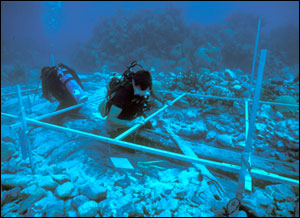Maritime Archaeology
Maritime archaeology is the study of past human cultures with an emphasis on how humans interacted with the world's
oceans, lakes and river systems. It is used to interpret the material remains of these cultures including ships and
small craft, their crews and cargoes, and their shore-based facilities. While maritime archaeology is best known for
its focus on shipwrecks, it is really the study of everything connected to seafaring. It is concerned with all aspects
of maritime culture including technological, social, economic, political, and religious topics.
 The discipline of archaeology has been recognized as a science for nearly one hundred and fifty
years, but maritime archaeology is a relative newcomer. In the early 1900's, sponge divers in the Mediterranean
discovered spectacular marble and bronze statues on the seafloor. These finds were much publicized, but resulted
in salvage operations rather than systematic documentation. The artifacts were recovered, but for the most part
the shipwrecks themselves were ignored. It was not until 1960 that maritime archaeology became a science. That
summer, George Bass was invited by the Turkish government to lead an excavation on what became known as the Cape
Gelidonya Wreck. This was the first excavation where the supervising archaeologist both dove and excavated. More
importantly, this was also the first time where proven land archaeological techniques were adapted for the
underwater environment. Using these methods, the Cape Gelidonya Wreck became the first shipwreck to be entirely
excavated on the seafloor. A detailed report was published and artifacts from the site are on public display. The discipline of archaeology has been recognized as a science for nearly one hundred and fifty
years, but maritime archaeology is a relative newcomer. In the early 1900's, sponge divers in the Mediterranean
discovered spectacular marble and bronze statues on the seafloor. These finds were much publicized, but resulted
in salvage operations rather than systematic documentation. The artifacts were recovered, but for the most part
the shipwrecks themselves were ignored. It was not until 1960 that maritime archaeology became a science. That
summer, George Bass was invited by the Turkish government to lead an excavation on what became known as the Cape
Gelidonya Wreck. This was the first excavation where the supervising archaeologist both dove and excavated. More
importantly, this was also the first time where proven land archaeological techniques were adapted for the
underwater environment. Using these methods, the Cape Gelidonya Wreck became the first shipwreck to be entirely
excavated on the seafloor. A detailed report was published and artifacts from the site are on public display.
Since then, the field of maritime archaeology has grown tremendously and research is being conducted by federal and state governments, universities, non-profit and for-profit organizations, and
individuals. Maritime archaeologists use satellites to help reconstruct ancient shorelines and use side scan sonar
to peer miles underneath the ocean's surface. Submersibles capable of carrying passengers have given researchers a
first-hand view of previously inaccessible sites such as the RMS Titanic. And when the danger to researchers is
too great or cost prohibitive, remotely-operated vehicles (ROVs) are deployed. These unoccupied highly
maneuverable underwater robots can conduct basic tasks on the bottom and carry video images back to the surface.
NOAA's thirteen national marine sanctuaries contain a diverse collection of archaeological sites. The Maritime
Heritage Program has become the nation's leader in the exploration, documentation, and stewardship of these
resources. Since the first national marine sanctuary was created in 1975 with the newly discovered shipwreck of
the Civil War ironclad USS Monitor, NOAA has taken a leadership role in the protection of these fragile
sites. In addition to the Monitor, countless other archaeological sites have been discovered within the
national marine sanctuaries. NOAA's dedication to being the principle federal agency in maritime archaeology was
illustrated in 2000 with the establishment of the Thunder Bay National Marine Sanctuary and Underwater Preserve in
Alpena, Michigan, which maintains stewardship over one of the nation's most historically significant collections
of shipwrecks. That same dedication continues today in the Northwestern Hawaiian Islands Coral Reef Ecosystem
Reserve, which is in the designation process to become the 14th national marine sanctuary. This proposed sanctuary
is best known for its pristine natural resources, but it also contains the shipwrecks of early exploration vessels
and whalers, which were a vital part of the United States and the world's economy in the seventeenth and
eighteenth centuries.
The United States became a world power through its maritime commerce and naval strength. Using maritime archaeology
to document these material remains helps us rediscover that proud legacy by bringing a physical connection to our
past. Through the Maritime Heritage Program, NOAA's National Marine Sanctuaries confirm its commitment to preserve
our rich maritime heritage not only for today, but also for future generations.
|





